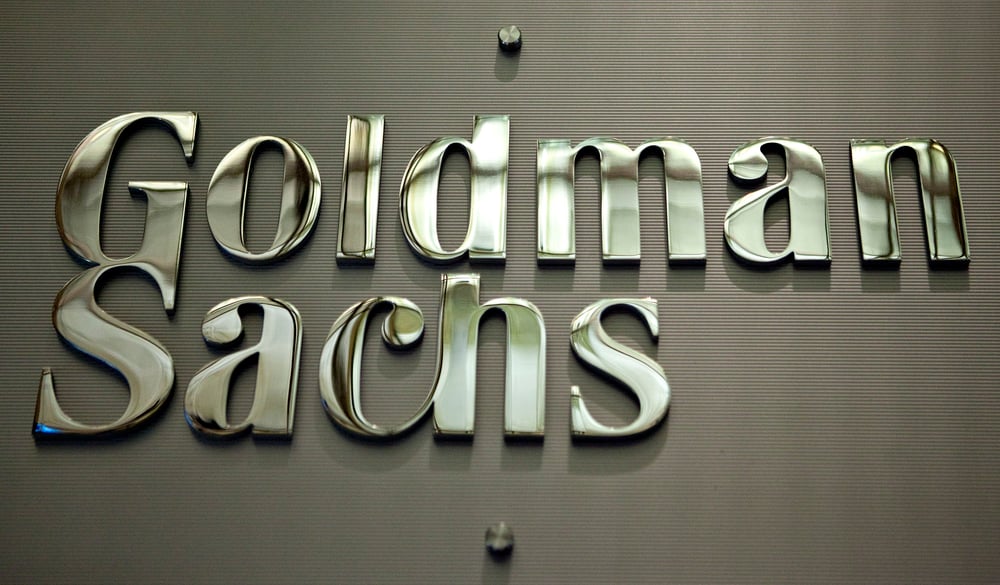Issue of 30-year notes a big hit; hiked reward for standing out on the yield curve
Goldman Sachs Group Inc.'s first sale of 30-year bonds in more than three years signals waning investor concern that inflation is accelerating. The debt soared in its first full day of trading.
The fifth-biggest U.S. bank by assets received $9 billion in orders for its $2.5 billion of notes sold on Jan. 21, according to Mizuho Securities USA. The 6.25 percent senior bonds priced to yield 170 basis points more than similar- maturity Treasuries, at the low end of a 5-basis-point range marketed by the firm, data compiled by Bloomberg show.
Economists are lowering forecasts for consumer price rises next year, with the median estimate declining to 1.9 percent this month from 2 percent in December, according to a Bloomberg survey. The record $13 billion auction of 10-year Treasury Inflation-Protected Securities on Jan. 20 attracted lower-than-average demand and the difference between yields on 10-year notes and TIPS narrowed the most since May.
“People aren't too worried about inflation,” said Anthony Valeri, market strategist with LPL Financial Corp. in San Diego, which oversees $293 billion. “Goldman was noticing there's some demand here and they could get that deal done.”
Thirty-year Treasuries yield 307 basis points, or 3.07 percentage points, more than the consumer price index, above the average of 238 basis points since the start of 2000. Goldman Sachs predicts a 0.6 percent increase in personal consumption expenditures this year, compared with the median 1.05 percent of 59 economists surveyed by Bloomberg.
Goldman Sachs's last benchmark-sized offering of 30-year dollar-denominated bonds was in September 2007, Bloomberg data show. New York-based Goldman Sachs, the most profitable securities firm in Wall Street history, then issued $2.5 billion of 6.75 percent debt at a 190 basis-point spread, Bloomberg data show. Benchmark sales are typically at least $500 million.
‘Satiate' Demand
“With Goldman Sachs doing a 30-year, it allows them to satiate some of the demand in the 30-year part of the curve and gets them close to all the buyers that are knocking on their door for bonds with duration,” said Timothy Cox, an executive director of debt capital markets at Mizuho in New York.
Goldman Sachs sold the bonds after reporting on Jan. 19 that fourth-quarter net income dropped 52 percent as a slowdown in trading and investment banking reduced revenue.
It may have offered the long-maturity debt to get ahead of an increase in borrowing costs, said LPL's Valeri. Yields on 30- year Treasuries climbed last week to 4.61 percent, the highest since April.
“They're probably saying, ‘Look, this 30-year's still not performing well, it's bumping along in terms of price, let's get this debt done now before interest rates get higher,'” Valeri said. “As an investor you're being compensated more to stand out on the yield curve. You're getting more yield for extending the maturity.”
‘Buckets' to Fill
Michael DuVally, a spokesman for Goldman Sachs, said the firm doesn't comment on its own deals.
Including Goldman Sachs's offering, companies have issued $5.32 billion of 30-year debt in dollars this month, up from $1.5 billion in December, Bloomberg data show. That compares with an $8.86 billion average in the first 11 months of 2010.
“A lot of investors have buckets they need to fill up within their portfolios, and there's a need for 30-year paper,” said Rajeev Sharma, a money manager at First Investors Management in New York, who helps oversee $1.5 billion of investment-grade credit. “It's very hard to get 30-years out there.”
The U.S. auction of 10-year TIPS on Jan. 20 drew a yield of 1.17 percent, compared with an average forecast of 1.108 percent in a Bloomberg survey of nine of the Federal Reserve's 18 primary dealers, who are obligated to bid in U.S. debt auctions. The yield at the last auction of the maturity on Nov. 4 was the lowest ever, 0.409 percent.
Inflation Bets
The sale was the largest 10-year TIPS offering since the government began selling inflation-indexed debt in 1997.
The bid-to-cover ratio, which gauges demand by comparing the amount offered with the amount sold, was 2.37, the lowest since April 2009. It was 2.91 at the last sale in November and averaged 2.73 at the past 10 offerings.
“Inflation expectations implied by TIPS are down this week,” Valeri said. “That's probably motivating investors to feel more comfortable with long-term debt.”
Yields on 10-year TIPS show bondholders expect the consumer price index to increase 219 basis points a year on average over the life of the debt. The CPI rate rose 1.5 percent in 2010 and is forecast to climb 1.7 percent this year, based on a Bloomberg survey of more than 60 economists.
Breakeven Rate
The so-called breakeven rate on TIPS reached 2.41 on Jan. 5 and is up from 1.51 percent in August amid concern that the $600 billion of cash the Federal Reserve will print to buy Treasuries would cause faster inflation.
U.S. corporate bonds due in 15 years or more are poised for a fifth consecutive month of declines, losing 1.23 percent in January, the worst-performing class in the Bank of America Merrill Lynch indexes.
The last benchmark offering of 30-year debt by a U.S. bank was in October, when New York-based JPMorgan sold $1.25 billion of bonds, Bloomberg data show. The 5.5 percent securities paid a spread of 165 basis points. Goldman Sachs sold $1.3 billion of 50-year debt on Oct. 26, Bloomberg data show. The bonds were offered in $25 denominations and can't be called, or redeemed, for five years, the bank said in a regulatory filing.
Goldman Sachs “is saying, ‘Hey, listen, the market wants this, let's give it to them because if we do this a year from now, there's a good chance rates could be up 100 basis points,'” Mizuho's Cox said. “If you believe we're in the beginning of a recovery, then you would certainly anticipate the 30-year to move up in yield.”
--Bloomberg News--







